Microsoft Azure Security Technologies (AZ-500)
Network Security
Implement load balancing
In this guide, we explore how to implement load balancing using Azure Load Balancer, a layer 4 load balancer that distributes incoming traffic across multiple servers. This configuration helps ensure that no single server becomes overwhelmed, thereby maintaining high availability and reliability in your environment.
Azure Load Balancer consists of three major components:
- Frontend: The entry point for incoming requests (the load balancer itself, not your application).
- Backend: The pool where your application servers reside.
- Load Balancing Rules: These rules define how traffic is routed from the frontend to the backend.
Below, we discuss the two primary SKUs (Stock Keeping Units) of Azure Load Balancer: Basic and Standard.
Azure Load Balancer SKUs
Basic SKU
The Basic Load Balancer is ideal for development and testing environments due to its simplicity and cost-effectiveness. Key characteristics include:
- Basic load balancing capabilities
- Operates within an availability set in the same data center
- Supports up to 300 instances
- TCP and HTTP health probe support
- Optional integration with Network Security Groups (NSGs)
- No redundancy and lacks an SLA guarantee
Standard SKU
Designed for production workloads, the Standard Load Balancer provides advanced features and higher performance:
- Availability zones and cross-region load balancing support
- Microsoft peering for enterprise-grade applications
- Scale support for up to 1000 instances
- Enhanced diagnostic features, including HA ports and TCP reset
- Strict NSG enforcement for improved security
- 99.99% SLA for production environments
Below is a comparison diagram summarizing the features of the Basic and Standard SKUs:
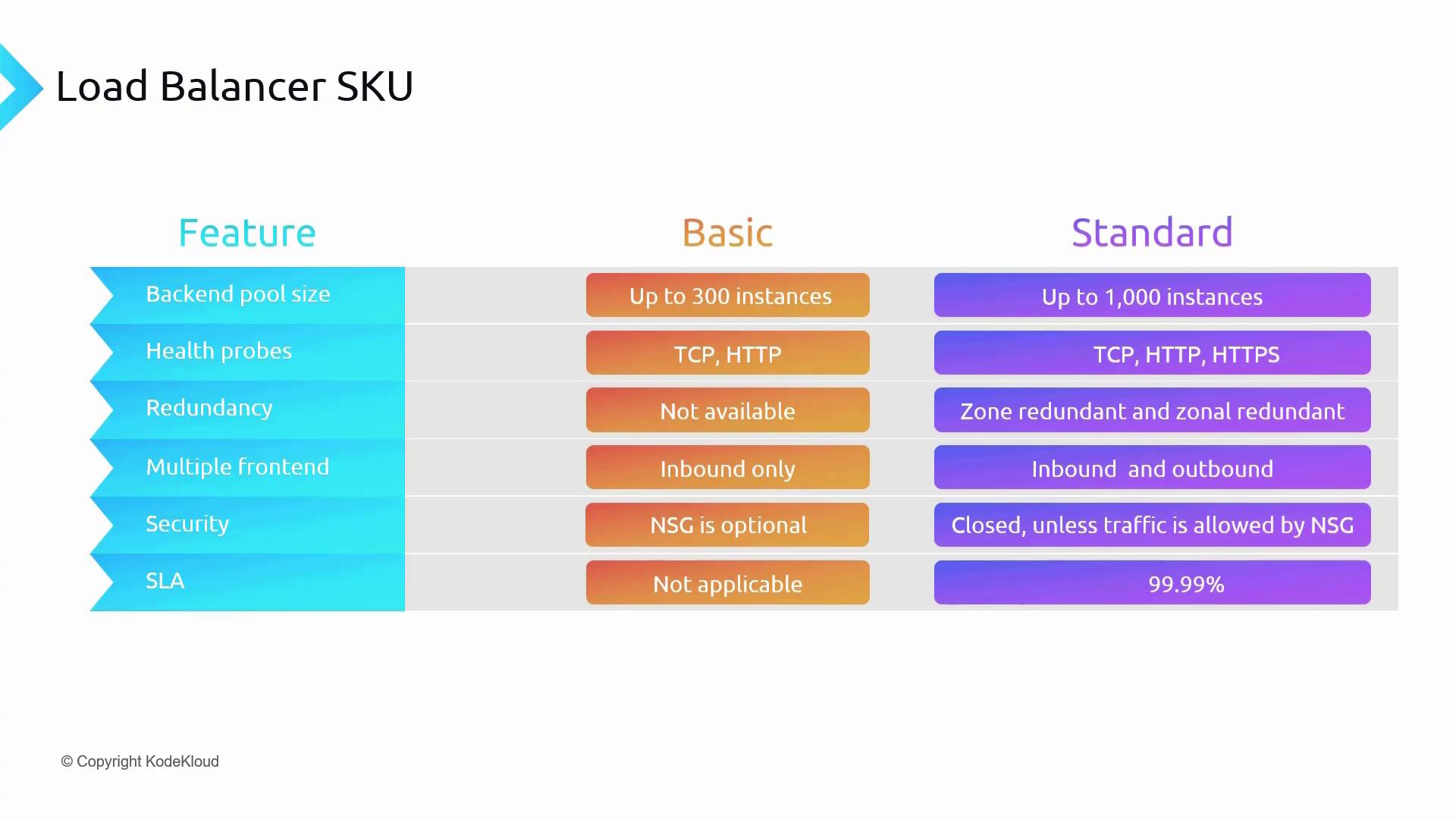
Note
For non-critical development or testing workloads, the Basic SKU may be sufficient. However, for production deployments requiring scalability and enhanced reliability, the Standard SKU is recommended.
Load Balancer Types: Public and Internal
Public Load Balancer
For scenarios such as hosting a static website in a virtual network's web subnet, a Public Load Balancer is used. It features a frontend with a public IP address, enabling end users to access your website on port 80 via the DNS name or public IP address.
The following diagram illustrates a typical Public Load Balancer setup:
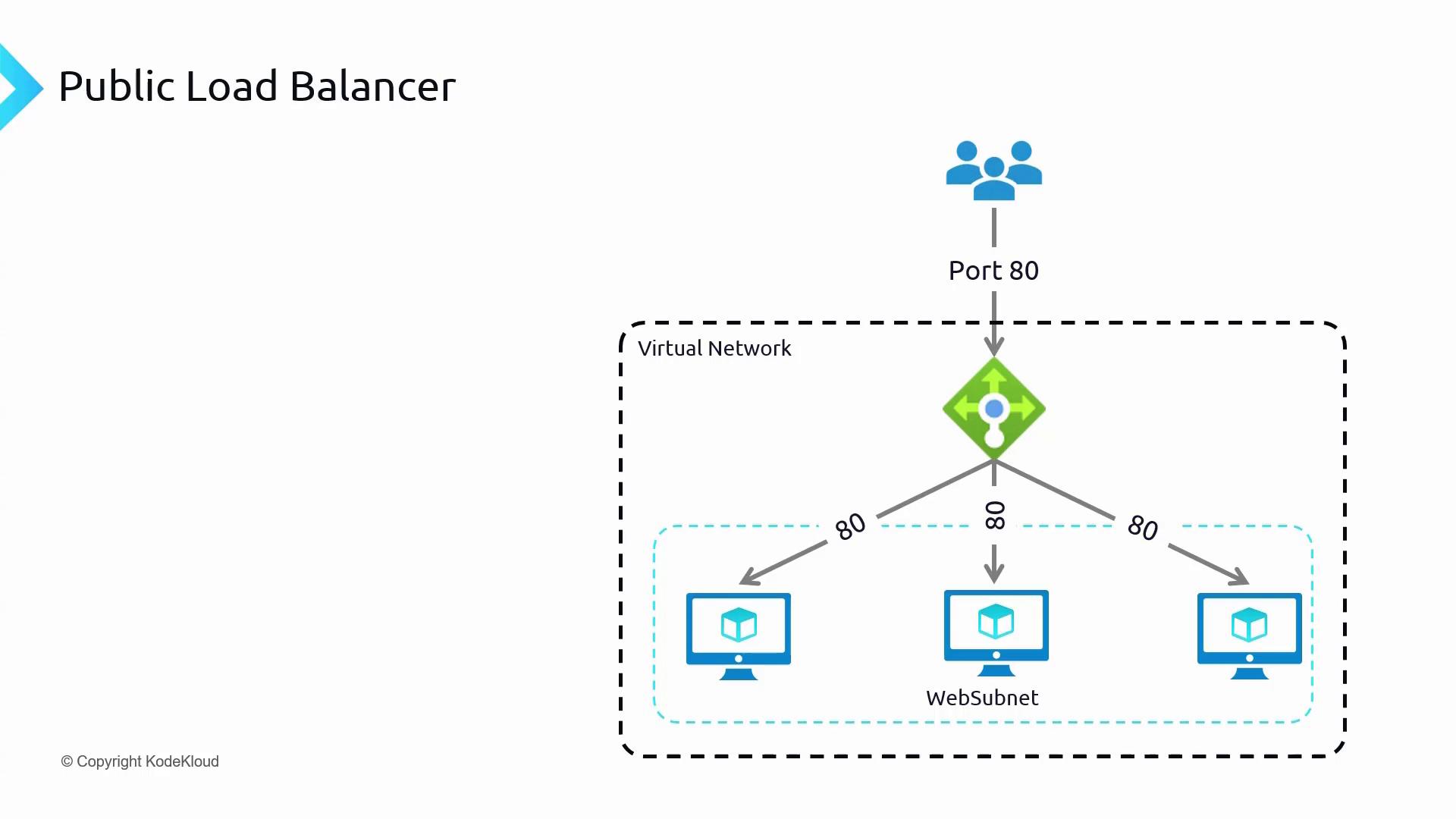
Internal Load Balancer
An Internal Load Balancer is best suited for distributing traffic among servers that handle internal workloads. For example, if you have a backend database that should not be exposed to the internet, an Internal Load Balancer (without a public IP) can distribute traffic securely among your database servers.
Deploying the Infrastructure
Before configuring the load balancer, deploy the required infrastructure using the "ACLB Prep Infra" script. This script creates necessary resources including:
- Three web servers deployed within an availability set
- A jump server for management access
Below is a sample output from the deployment script:
Creating availability set
---------------------------------
Setting VM config
Setting OS Profile
Creating VM webserver-01
RequestId :
IsSuccessStatusCode : True
StatusCode : OK
ReasonPhrase : OK
---------------------------------
Setting VM config
Setting OS Profile
Creating VM webserver-02
RequestId :
IsSuccessStatusCode : True
StatusCode : OK
ReasonPhrase : OK
---------------------------------
Setting VM config
Setting OS Profile
Creating VM webserver-03
RequestId :
IsSuccessStatusCode : True
StatusCode : OK
ReasonPhrase : OK
Creating jumpbox VM
The script also outputs virtual network configuration details. For example:
AddressSpace : Microsoft.Azure.Commands.Network.Models.PSAddressSpace
DhcpOptions : Microsoft.Azure.Commands.Network.Models.PSDhcpOptions
FlowTimeoutInMinutes : {jumpboxSubnet, webSubnet}
BgpCommunities : {}
Encryption :
VirtualNetworkPeerings : {}
ProvisioningState : Succeeded
EnableDdosProtection : False
DdosProtectionPlan :
IpAllocations : {}
ExtendedLocation :
AddressSpaceText :
"AddressPrefixes": [
"10.0.0.0/16"
]
DhcpOptionsText :
FlowTimeoutInMinutesText : null
SubnetsText :
"Delegations": [
{
"Name": "jumpboxSubnet",
"Etag": "W/\"e7e40ac8-5d59-49d2-8b0c-34ce3c3d8cbb\"",
"Id": "/subscriptions/3e17f8aa-ad65-4be0-a407-4dc4cac01a73/resourceGroups/rg-azlb-20230930/providers/Microsoft.Network/virtualNetworks/eus-web-dev/subnets/jumpboxSubnet"
}
]
Notice that the jump server is assigned a public IP address to facilitate SSH access, while the web servers remain without public IP addresses.
After deployment, verify the resources using the Azure Portal. The resource group should contain the three web servers and the jump server, all within the same virtual network, ensuring seamless internal communication.
Configuring the Public Load Balancer
Follow these steps to configure a standard public-facing load balancer via the Azure Portal:
Create the Load Balancer:
- Select the region (e.g., East US) and set the SKU to Standard.
- Choose "Public" as the type and "Regional" for the deployment model.
Configure the Frontend IP:
- Create a new public IP address (e.g., "web LB PIP").
- This public IP will serve as the entry point for the load balancer.
Configure the Backend Pool:
- Establish a backend pool by adding all web servers from the "US Web Dev" availability set.
- Verify that all the web servers are included in the backend pool.
The diagram below shows the Azure Portal interface when adding IP configurations to the backend pool:
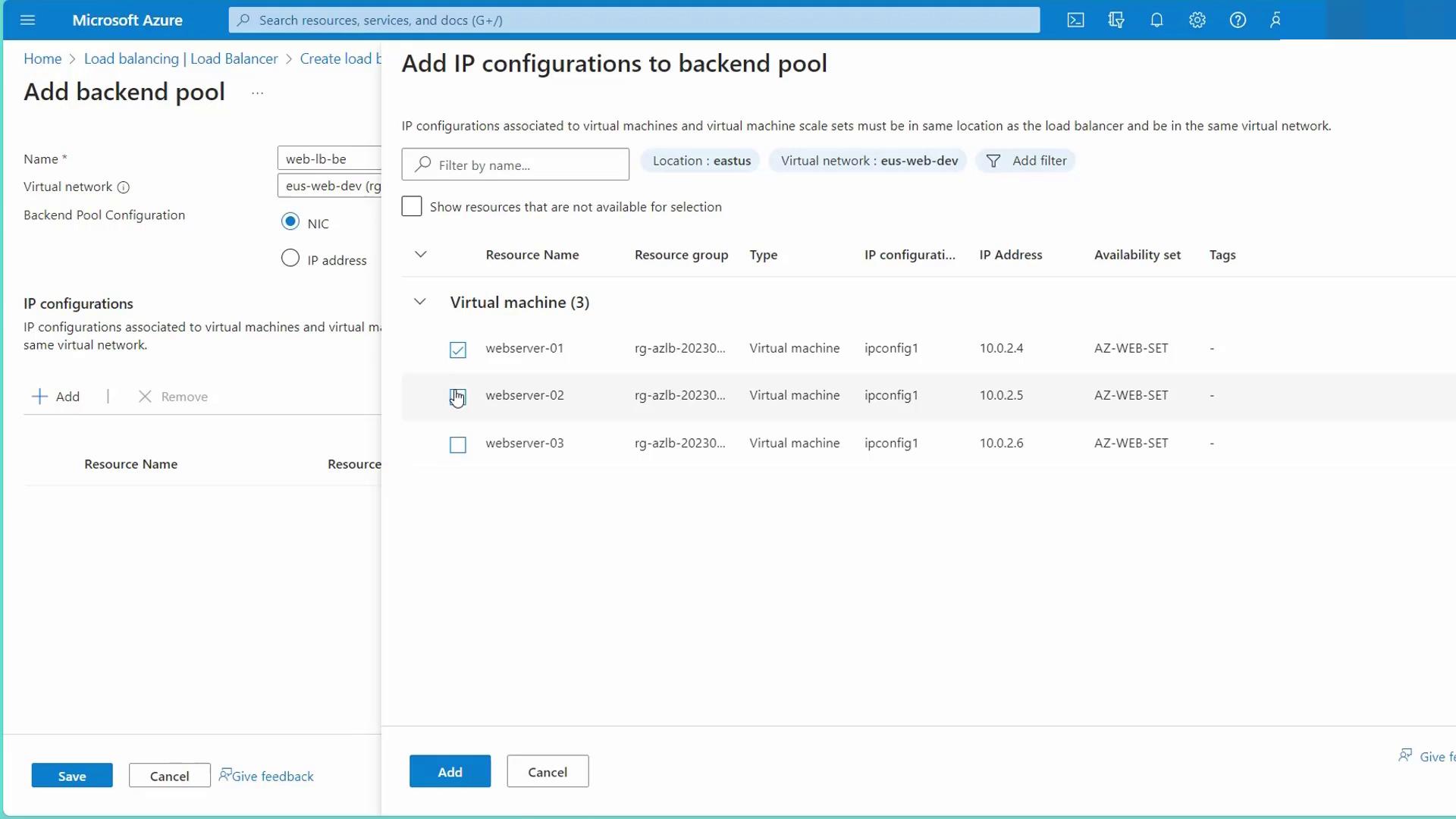
- Create Load Balancing Rules and Health Probes:
Load Balancing Rule:
Create a rule (e.g., "web LB rule HTTP") that links the frontend IP to the backend pool. Configure the protocol settings:- Frontend port: 80
- Backend port: 80 (or another port if your web server listens on a different port, e.g., 8080)
- Protocol: TCP
- Session persistence: Choose either None (default, uses a five-tuple hash) or Client IP based for sticky sessions.
Health Probe:
Establish a health probe (e.g., "web LB HP") that monitors backend server health. Choose between TCP (to check if the port is open) or HTTP (to send a web request expecting a 200 OK response). In this configuration, the probe checks the root path on port 80 every five seconds.
The diagram below illustrates the settings panel for configuring load balancer rules:
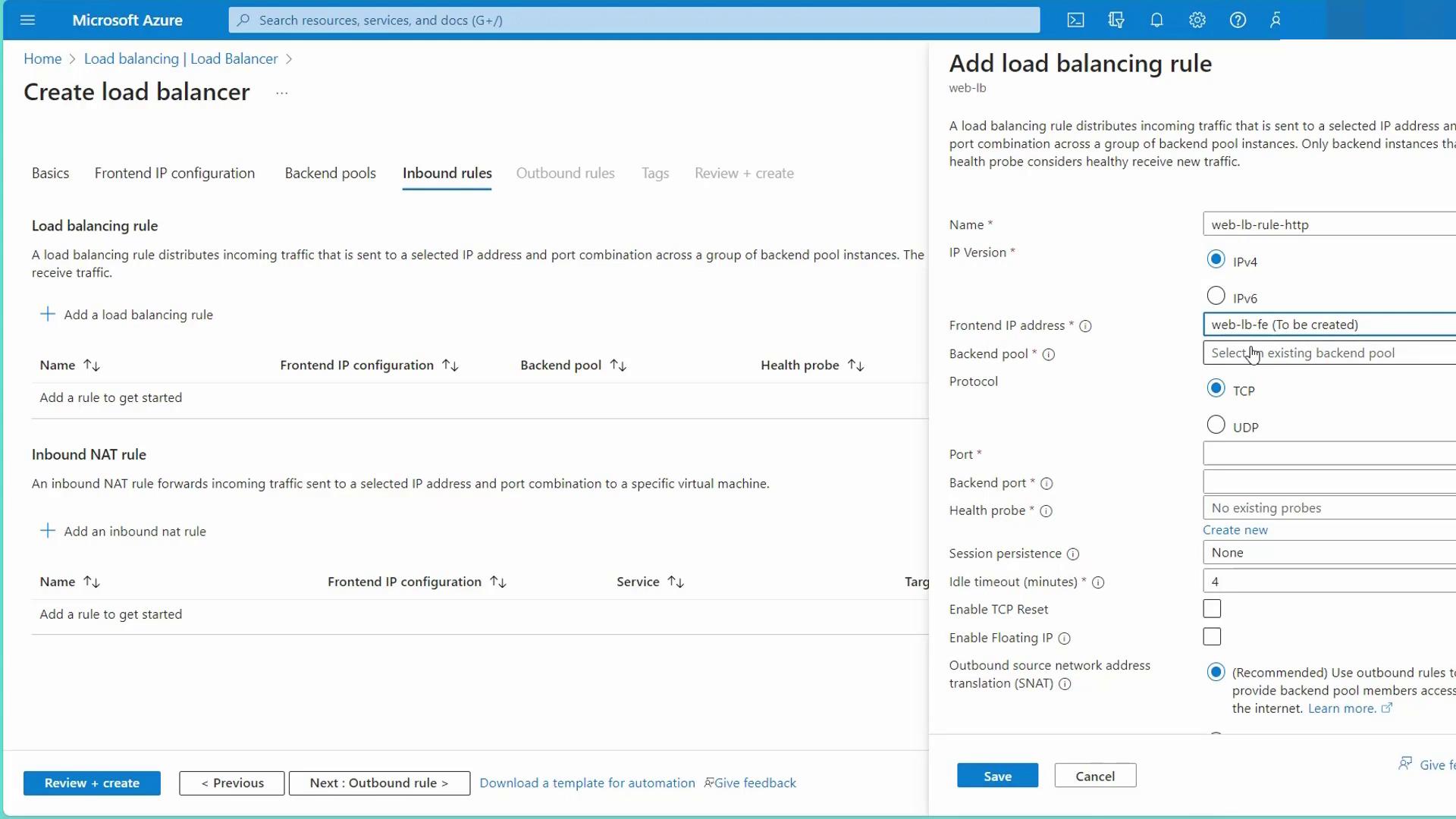
- Configure Inbound NAT Rules (if needed):
Use inbound NAT rules to enable direct access (e.g., SSH) to individual backend servers by mapping unique frontend ports (such as 22 or 3000) to port 22 on specific backend instances.
The diagram below focuses on configuring inbound NAT rules:
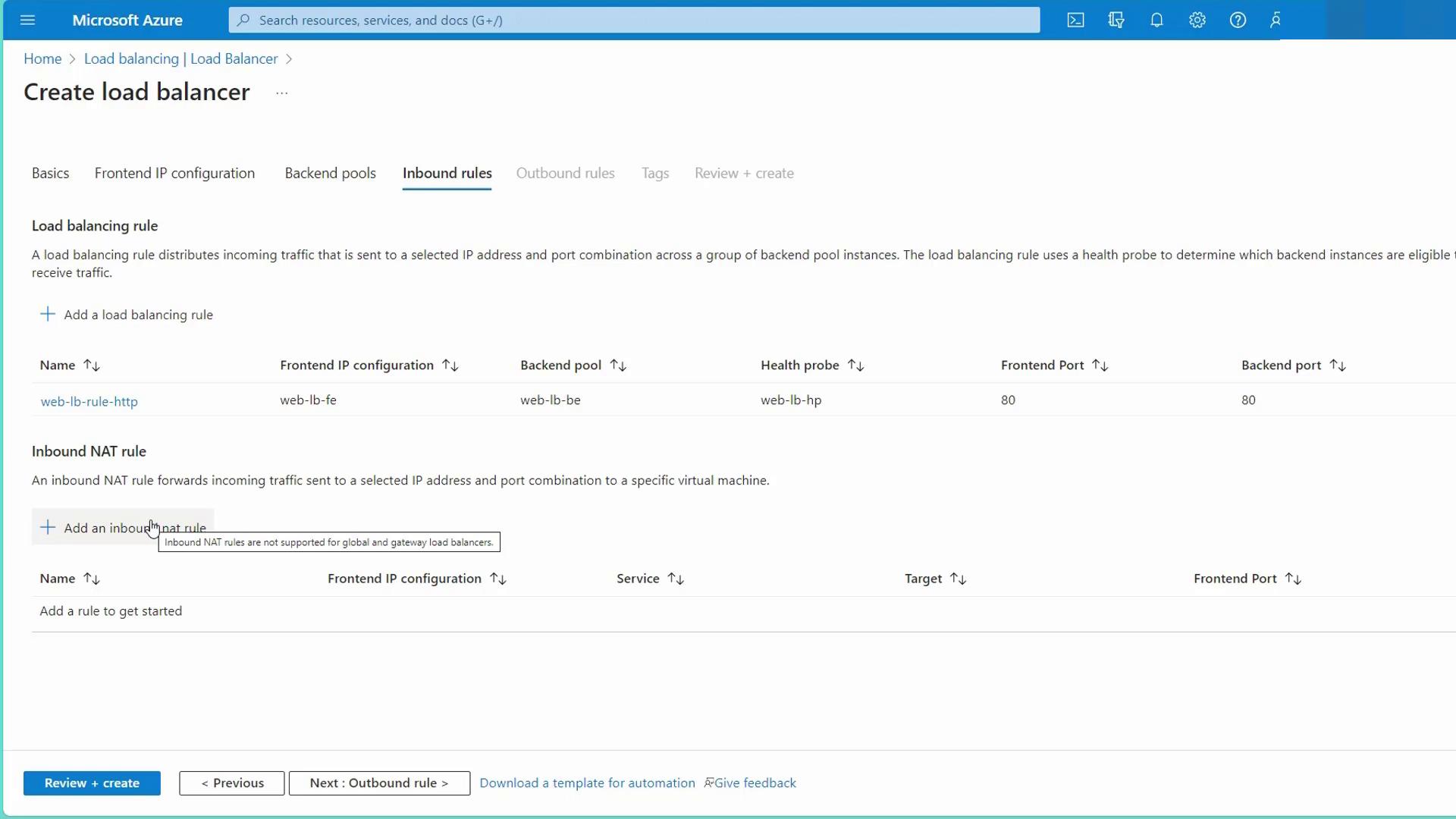
- Review and Create the Load Balancer:
Double-check all settings (frontend, backend, load balancing rules, and health probes) and create the load balancer. The resulting configuration will share the public IP address among the web servers, facilitating the distribution of incoming traffic based on your defined rules.
After creation, you can verify the load balancer and associated public IP address on the Azure Portal with the following interfaces:


Warning
Ensure that your NSG rules allow traffic on port 80 to avoid any disruption in load balancing functionality.
Testing the Load Balancer
After configuring the load balancer, test the setup by entering the frontend public IP address in your browser. You may observe varying responses (for instance, different colored pages) because the load balancer distributes traffic among backend servers using a five-tuple hashing mechanism (source IP, source port, destination IP, destination port, and protocol). This method might not strictly follow a round-robin pattern.
Verifying that you receive responses from different backend servers confirms that your load balancing configuration is working as intended.
Moving Forward
With the Azure Load Balancer now successfully distributing traffic across your web servers, you benefit from improved reliability, high availability, and enhanced security by keeping your web servers shielded from direct internet exposure. In future discussions, we will explore the Application Gateway—an alternative Azure service that provides advanced load balancing features to further optimize your infrastructure deployments.
For more details on Azure services, check out these resources:
Happy scaling!
Watch Video
Watch video content